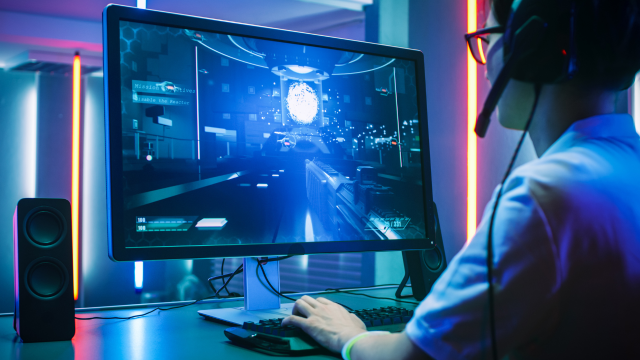If you’re buying a new display, there’s a lot of lingo that you should be across, just to make sure you know what you’re buying. Unfortunately, we’ve gotten to a point with displays where there’s a lot of confusing technology lingo employed to describe what a computer monitor is capable of.
But it doesn’t have to be so daunting. We’re going to go through some common display-related lingo below to demystify the important technology that goes into making some panels so good (and could be the difference between a purchase or not). Let’s get cracking.
What’s the difference between LCD and OLED?
LCD, or liquid crystal display, is the standard type of monitor today. The technology uses backlights to create colour through the display’s pixels. Meanwhile, OLED panels light pixels individually, effectively leading to greater darkness and more satisfying colours.
OLED panels aren’t particularly common on computer monitors at the moment, but they’re starting to be rolled out, starting with more expensive gaming-oriented displays. For the most part, LCD displays still look good – the colours on an OLED panel, and especially darkness, look much better.
What’s the difference between IPS and VA?
As RTings reports, the difference between IPS (In-Plane Switching) and VA (Vertical Alignment) boils down to crystal orientation in the panel. IPS panels (the more popular of the two for monitors) are oriented horizontally, while VA panels are oriented vertically (more common in TVs).
The main performance difference between IPS and VA panels are trade-offs: VA panels have better contrast (aka the depth of black shades visible) and black uniformity, while IPS monitors have better vertical and horizontal viewing angles, colour depth and motion handling at high refresh rates.
OLED panels do not use IPS or VA and are entirely separate.
What’s the difference between a 1080p, 2K or 4K resolution on a monitor?
1080p, 2K and 4K are different resolutions that a monitor performs at, effectively giving you better picture quality as pixel density increases. 1080p (FHD) has the lowest pixel density, 2K (QHD) is in the middle, and 4K (UHD) is at the top.
That being said, the resolution isn’t the be-all and end-all. On smaller sub-30-inch monitors, for example, you likely won’t mind having a 1080p display. 1080p doesn’t look bad at all and is perfectly fine for gaming at all levels (unless you deeply care about picture quality) and productivity.
However, if you insist on having sharp gaming graphics and streaming at higher resolutions, you’ll need a monitor that can support such things. These monitors are more expensive and for gaming, can be more demanding on your system to process at higher resolutions, but they do generally look nicer than 1080p. It’s all just balancing trade-offs.
What does HDR mean?
HDR stands for ‘High Dynamic Range’, and it basically amounts to an improvement in the colours capable of being produced on a monitor, as directed by the application. Basically put, as explained by Cool Blue, HDR is a software-enabled setting that some monitors come with.
Games, streaming services and applications will need to support HDR capability to have the potential greater colour range transmitted to the monitor. Support for this setting varies from application to application.
HDR can improve the image colour and the contrast of a game or application, but your monitor will need to support it as a setting, and you’ll need to enable it in your PC settings.
What is ‘Hz’ or ‘refresh rate’ on a monitor?
‘Hz’ (or hertz) and ‘refresh rate’ refer to the number of times your display refreshes per second, effectively making games or applications look smoother. If you care about having a nice, smooth-looking image, then you might want to purchase a monitor with a higher ‘hz’ number (such as 120hz, 144hz or 165hz).
Refresh rates can go much higher than 165hz, depending on the monitor you’re interested in buying, but you’re unlikely to get any performance value out of a refresh rate this high, as high refresh rates are performance-intensive.
Additionally, if you’re only using your monitor for streaming content, you’re unlikely to get much value out of a higher refresh rate display. The screen will generally look smoother outside of streaming, but when you are streaming, you’ll be locked to the frame rate provided by the streaming service, which is content specific. Most shows stick to between 24 and 60 fps, which are perfectly achievable framerates for most monitors.
What is ‘ms’ on a monitor?
‘Ms’ on a computer monitor refers to the millisecond response time the monitor offers. If it offers 2ms, then any actions you input via the keyboard or mouse will be translated to actions on the screen within 2 milliseconds. If the monitor offers 10ms, then it’s the same but within 10 milliseconds.
To the average user, there’s not a tremendous advantage in having an ultra-fast millisecond response time on a monitor, so the advantages are typically reserved for highly competitive gamers where every little moment counts. You’ll usually see lower response times coupled with gaming monitors.
And that’s about it
That’s about it for the main computer monitor terms that you’ll come across when shopping for a monitor, but if you think we’ve missed one, let us know.

Comments